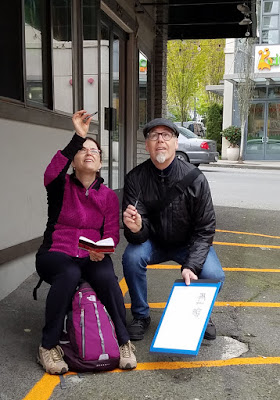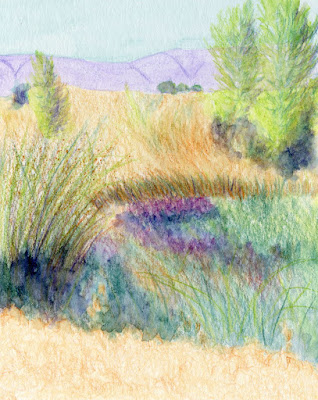 |
| 4/22/17 ink, watercolor |
As all construction sites are, the building going up at
Ninth and Howell in downtown Seattle is a formidable and intimidating sketch
subject. But David Chamness promised
us “freedom from worry and the details” as we tackled the site in his USk 10x10 workshop. He encouraged us to
stay loose and fast with the sketch while having fun and engaging with
passers-by.
On a cloudy but fortunately mostly dry morning yesterday, a
dozen of us began by making small thumbnails to divide the intimidating scene into
manageable compositions. David suggested taking smartphone photos to help us view
various compositions. Giving a brief drawing demo, he explained how to identify
the horizon line and vanishing point and how to take relative measurements of
elements and angles with our pens.
Next we drew a complete scene using one of our thumbnails
as a reminder of the composition. (“Look at the thumbnail briefly, then put it
away and look at the actual scene while you draw,” he said, “don’t draw from
the thumbnail.”) David urged us to draw with bold, confident ink lines, not dashed,
sketchy pencil lines. (“You don’t want to draw it twice or spend time erasing.”)
As we drew, he gave us more pointers like using the whole arm – not just wrist –
to draw long, straight lines, and using the “rule of thirds” to make
interesting compositions.
 |
| David giving a watercolor demo. |
During a brief watercolor demo, David showed us his signature
painting style: bold, sometimes “unrealistic” colors put down quickly with a
large brush. Moving from lightest to darkest colors, he showed us how values support
the forms and shapes in the drawing. He also moves from the top down on the
page to avoid dragging his hand through wet paint. After the demo we made our
final sketch of the workshop – on large paper, at least 9-by-12 inches, and
finished with watercolor. (He recommends taping a sheet of watercolor paper to
a board for support.)
Shown at the top of the post is my final sketch. Whenever
I take workshops, I usually end up feeling like the resulting sketches are not
my spontaneous responses to the subject because they are assigned by the
instructor, who has a specific objective in mind for the exercise. I maintain
the attitude, however, that I’m there to learn more than to make spontaneous
sketches, so the results don’t bother me. I have to say, though, that this
sketch is one of few workshop sketches I actually like because it did feel like
a genuine, fresh response. Influenced by David’s approach and feedback, it is
looser and bolder than most scenes I’ve sketched under the duress of being
intimidated by huge and complex subject matter. Free of worries, indeed!
 |
| A few thumbnails |
Incidentally, this was the first time I used watercolors on
location since I committed to using colored pencils exclusively last fall. Although
I haven’t missed watercolors, it was fun to splash around with a wide brush (I
even used a real ¾-inch brush recommended by David instead of my usual
waterbrush) to make bold streaks of color. While I’m generally more attracted to
the finer lines and details I can get with colored pencils, there’s a place for
loose, splashy marks, too. I’d like to find a way to get both from one medium,
but that’s a tall order.
One thing that was definitely confirmed, though, was that
I don’t like the extra baggage that painting requires – somewhere to sit; supporting
a painting board with my lap; bending over to dip into paints, a mixing tray
and water; cleaning up afterwards. Each sketching medium has its pros and cons.
I think I’ve made my choice with colored pencils, but every choice means giving
up the benefits of the alternatives not taken.
 |
| Our intimidating sketch subject! |
 |
| Workshop students hard at work. |
 |
| A bus shelter makes a handy studio. |
 |
| David helps Svetlana take a measurement. |
 |
| Final throwdown and critique. |











































